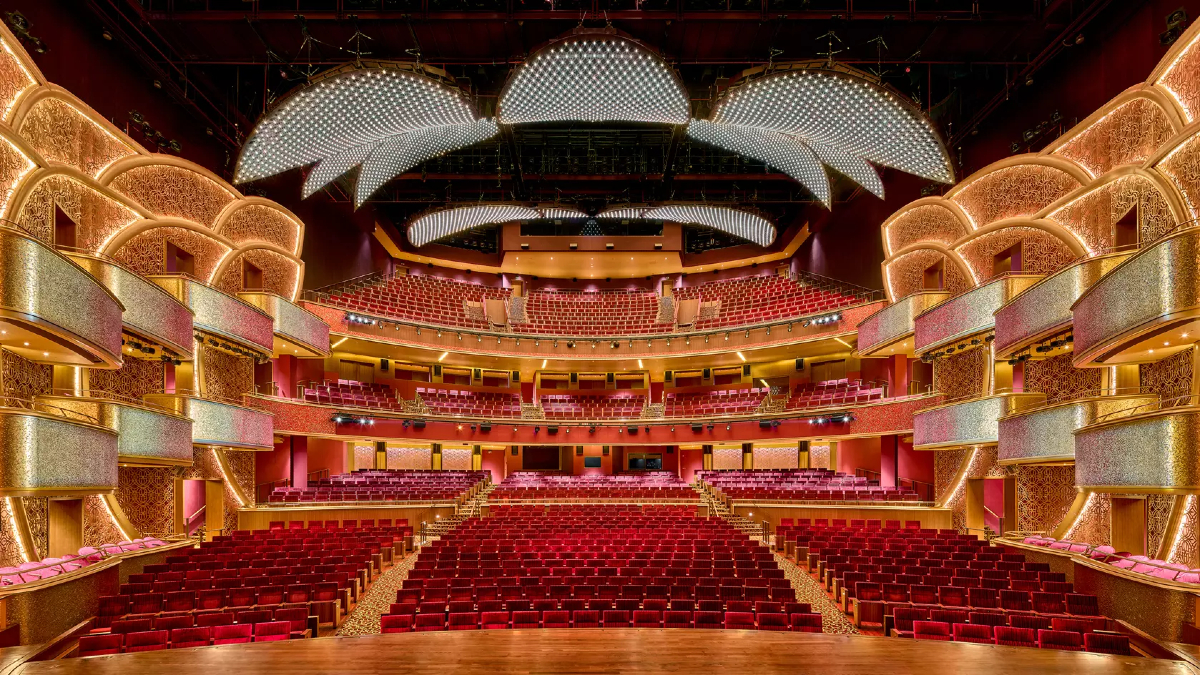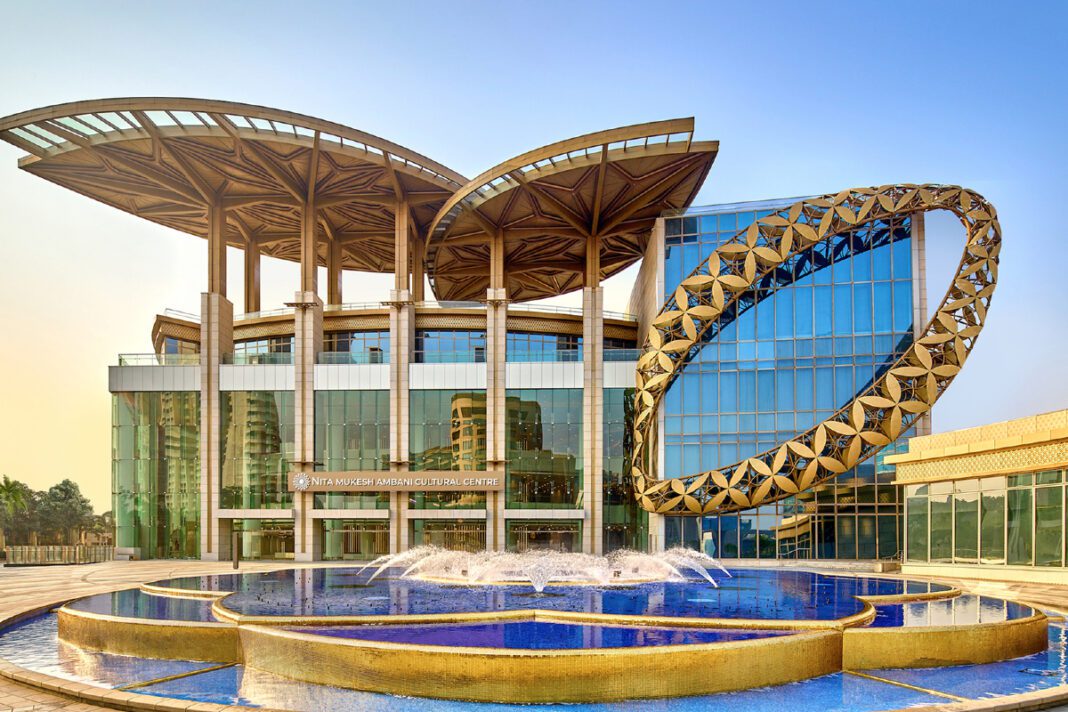A new artistic jewel graces Mumbai’s cultural scene: the Nita Mukesh Ambani Cultural Centre (NMACC). This first-of-its-kind, multi-disciplinary space is a vibrant platform designed to ignite artistic curiosity within the community. Strategically located in the heart of Bandra Kurla Complex, in Mumbai, the NMACC serves as a grand stage for showcasing India’s art and culture at its finest, for both artists and audiences.
More than just a modern interpretation of Indian design, the NMACC embodies the nation’s rich heritage. Inspired by its art, craft, and people, the sprawling spaces exude a sense of openness. Built on a foundation of strong design language, the centre is a visual feast featuring traditional lotus motifs, semi-precious stones, intricate jaali work, and all bathed in lush jewel tones. It fosters a strong connection between the community and various art forms, forging a bridge between past and present.
According to structural consultant, Dineshchandra P Bhaud, General Manager, Sterling Engineering Consultancy Services Pvt Ltd, the NMACC’s design brief was a clear vision: to create a platform that not only celebrates established Indian arts and culture but aspires to be the grand stage for its future. It’s a dedicated multi-disciplinary space, nurturing artistic exploration and identifying and promoting the talents of tomorrow.
A Multi-Disciplinary Art & Culture Hub
Art House: A four-storey art and culture space
– 16,000 sq ft
– Global and Indian art installations
– Workshops and tech programs
– Cuff bracelet-inspired facade
The Cube: Incubator of innovation, talent, and ideas
– 125 seats with movable stage
– Panasonic projection and assisted listening
– 5G-enabled recording and streaming
The Grand Theatre: Designed for immersive experiences
– 2,000 seats, Dolby Atmos sound
– 8,400+ Swarovski crystals
– Integrated recording and translation booths
– 18 Diamond Boxes with private lounges and butler service
Diamond Boxes: Exclusive seats in The Grand Theatre
– Private lounge and amenities
– Curated gourmet menu
– Dedicated butler service
The Studio Theatre: High-tech, intimate performance space
– Telescopic seating
– Dolby Atmos sound
– Advanced soundproofing
– Tension wire grid for lighting and rigging
Pavilion 1: Transformative museum-like space
– 52,627 sq ft
– Large LED display walls
– Digital signage and 1 tonne hanging points
– 5G-enabled, temperature control
– Ideal for art shows and exhibitions
Thinking Outside the Box
NMACC also boasts India’s first international theatre – the awe-inspiring Grand Theatre. This marvel can accommodate a 2,000 strong audience and features a large orchestra pit fit for a staggering 80 musicians. But the magic goes beyond the grand scale; the theatre’s success hinges on meticulous engineering.
The construction process began with the creation of a sturdy foundation. Towering 600 mm thick RCC walls were cast first, forming a robust box structure. Next came the feat of erecting a 40 m spanning roof truss.
Steel played a vital role throughout the project. A staggering 2,000 MT of structural steel were fabricated, customised, and detailed to meet both the functional and aesthetic requirements of the Grand Theatre.
From conception to completion, the Grand Theatre rose in just two years – a testament to the dedication and expertise of those involved. The use of structural steel was crucial in meeting this ambitious timeline. Steel’s inherent strength allowed for large spans and intricate detailing, ensuring both structural integrity and visual appeal.
The Science Behind the Spectacle
Steel’s inherent flexibility allowed for intricate and complex detailing, crucial for transforming the architect’s vision into reality. This moldability was essential in crafting the unique and iconic structure of the Grand Theatre. TVS Design Architects envisioned the theatre in the form of a majestic orchid flower. Steel’s versatility proved instrumental in translating this organic design into a functional and visually stunning structure.
The surrounding structure around the theatre is a robust RCC shear wall, forming a closed box structure above the ground floor. This provided a solid base for the rest of the building. The theatre walls themselves are cleverly ‘floated’ above the ground floor, creating a unique design element.
Since the theatre was part of a larger convention centre complex, its construction timeline was critical. Steel’s inherent advantages, including faster construction compared to concrete, made it the ideal choice. The decision to prioritise the construction of the RCC perimeter box walls further ensured the project stayed on track.
The next major feat was the erection of a top truss spanning a colossal 40 m. This crucial element provided the structural support for the vast roof of the theatre. Following the completion of the top trusses, the intricate internal structural steelwork of the theatre was installed. This network of steel beams and columns forms the backbone of the entire structure.
Casting free-standing RCC walls to a height of 35 m also posed a significant challenge. To prevent lateral buckling (collapse inwards) of these tall walls, horizontal steel trusses were strategically placed. This clever solution ensured the structural integrity of the theatre walls.
 Conquering Challenges
Conquering Challenges
The Grand Theatre’s awe-inspiring roof, spanning a massive 40 m, presented a significant construction hurdle. With the RCC walls already erected, conventionally erecting the trusses wasn’t feasible. The solution? A 350 tonne capacity crane was positioned strategically outside the theatre box. This allowed the team to assemble the trusses in sections and hoist them into place.
To ensure a smooth assembly process, the steel sections were custom-fabricated off-site to meet the exact design requirements. This prefabrication not only saved time but also ensured each piece perfectly fit within the overall structure.
The project also prioritised sustainability by using higher-grade concrete and structural steel. These materials not only offered superior strength but also minimised the overall amount of material needed, reducing the carbon footprint of the construction process.
These clever solutions showcase the adaptability and meticulous planning that went into constructing the Grand Theatre.
The NMACC is more than a building. From its breathtaking orchid-inspired form to its awe-inspiring 40 m roof, every element embodies a remarkable synergy. The meticulous planning and expert execution behind this project are even more impressive considering the strict timeline. But it isn’t just about strength and speed. It’s a visual masterpiece. The architects’ vision, translated through steel, has resulted in a structure that is both aesthetically grand and functionally exceptional.
This architectural marvel not only elevates Mumbai’s cultural landscape but sets a new standard for design in India.
Fact File
Project: Nita Mukesh Ambani Cultural Centre (NMACC), Mumbai
Client: Reliance Industries Ltd.
Architect: Architect TVS Design, Architect Hafeez Contractor
Consultant: Sterling Engineering Consultancy Services
Project Management: Samsung C&T
Fabricator: Eversendai
Supplier: Tata, JSW
Tonnage: 2000 MT
Status: Completed
Quote
“This project had very specific and special requirements in terms of architecture and utility. Additionally, factors like project construction timelines and large spans and detailing demanded structural steel be the ultimate choice for this project. Each steel member used in this structure is not only designed and provided as per structural design requirements but also has been selected, customised and detailed to meet the special needs for aesthetics and functionality. Complex and micro-level detailing was possible due to steel’s mouldability. We were able to use it to the fullest in making this unique and iconic structure.”
Dineshchandra P Bhaud, General Manager, Sterling Engineering Consultancy Services Pvt Ltd





